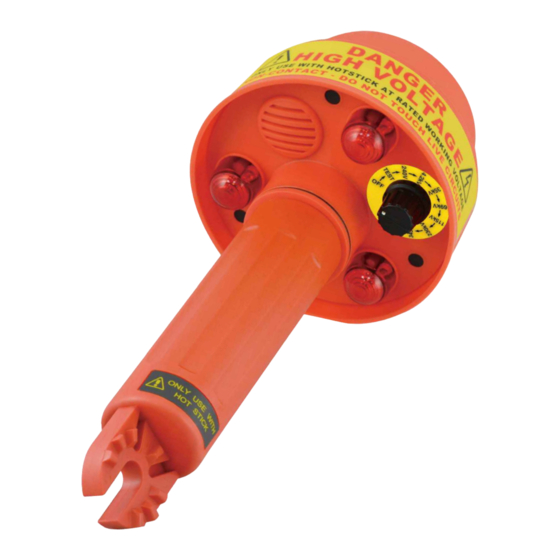
Table of Contents
Advertisement
Quick Links
Advertisement
Table of Contents

Subscribe to Our Youtube Channel
Summary of Contents for Besantek BST-HVD21
- Page 1 BST-HVD21 Non-Contact High Voltage Detector IP65 INSTRUCTION MANUAL...
-
Page 2: Table Of Contents
INDEX Page 1. Safety Rules........2. General Description......3. Low Voltage Testing......4. Instrument Layout........ 5. Preparation for Use......6. Checking and Proofing ....... 7. Typical Uses........8. Broken Wires in Cables ...... 9. High Voltage Testing......10. Faults (Open) Cables......11. -
Page 3: Safety Rules
1. Safety Rules The Non-contact high voltage detector has been designed with safety in mind. However, no design can completely protect against incorrect use. Electrical circuits are dangerous and lethal through lack of caution or poor safety practice. The following rules should reduce the danger: ˙... -
Page 4: General Description
This instrument should only be used by a competent, suitably trained person who understands this test procedure fully. Personnel working with high voltage Should be trained regularly. 2. General Description The Non-contact high voltage detector is a new water- proof design tool for checking the presence of AC high voltages and low voltages. -
Page 5: Low Voltage Testing
The trigger level is fixed (CMOS logical level change). The "Test" inserts a voltage on the sensor plate, just like if the sensor would pick up a voltage. The Non- contact high voltage detector allows identification of AC voltages. The enclosure is made out of industrial grade polyurethane. -
Page 6: Instrument Layout
4. Instrument Layout ① ③ ① ② ① ④ ⑤ ① LED indicators : High bright low current LEDs triggered on voltage detection. ② Rotary selector with the settings listed below : ˙OFF – Turn the pick-up sensor off ˙Test – Check if the entire circuitry is working ˙240V, 4.2kV, 35kV, 69kV, 115kV, 230kV, 345kV, 500kV ③... -
Page 7: Preparation For Use
5. Preparation for Use When unpacked, the Non-contact high voltage detector should be inspected for any visible signs of damage, and the preliminary checks described in the user manual should be performed to ensure that it is operating correctly. If there is any sign of damage, or if the instrument does not operate correctly, return it to your nearest supplier. -
Page 8: Typical Uses
7. Typical Uses ˙ Identify and check live cables. ˙ Check and detect live high voltage cables (using extension hot stick). ˙ Find fault in flexible cables. ˙ Check earth equipment. ˙ Trace live wires. ˙ Check high frequency radiation. ˙... - Page 9 ※ When working under high voltage systems, please wear the insulation gloves and rubber shoes. Do not touch live conductors with this Non-contact high voltage detector. An increase in voltage means an increase in its radiated field strength. The radiated field strength quickly decreases with distance and/or ground shielding.
-
Page 10: Faults (Open) Cables
10. Faults (Open) Cables The Non-contact high voltage detector is capable of detecting faults in certain flexible cables. For a cable that is still energized, set the detector's sensitivity so that it triggers. Move the detector along the cable until you notice a change. - Page 11 Problems can arise when the tertiary circuit of a 275/ 133/11kV transformer is tested. The electric field of the HV and MV bus bars can trigger the detector when it is about 3m above the ground. This is common with most of the electric field voltage detectors.
-
Page 12: Changing Batteries
Check and detect live high voltage ˙ cables(using extension hot stick.) 12. Changing Batteries The Non-contact high voltage detector uses 3 x 1.5V "C" type batteries. Open the battery holder (turn counter- clockwise) to remove the batteries. Ensure the polarity is correct. -
Page 13: Specifications
13. Specifications ˙ Operating Temperature : -10°C~50°C ˙ Storage Temperature : -20°C~60°C ˙ Humidity : 85% R.H. @ 40°C ˙ Case Height : 265mm ˙ Case Width : 117mm ˙ Weight : Approx. 600g(Batteries included) ˙ Power Source : 1.5V "C" x 3 Alkaline Batteries ˙... - Page 14 Disconnect hook ˙ Fuse extractor head ˙ Carry case ˙ -12-...
-
Page 15: Limited Warranty
14. Limited Warranty We warrant the product to be free from defective materials or factory workmanship. We agree to repair or replace this product with no charge for parts and service, if used under normal operation and is a result of manufacturer defects. - Page 16 We reserve the right to discontinue models at any time, or change specification, price or design, without notice and without incurring any obligation. -14-...















Need help?
Do you have a question about the BST-HVD21 and is the answer not in the manual?
Questions and answers